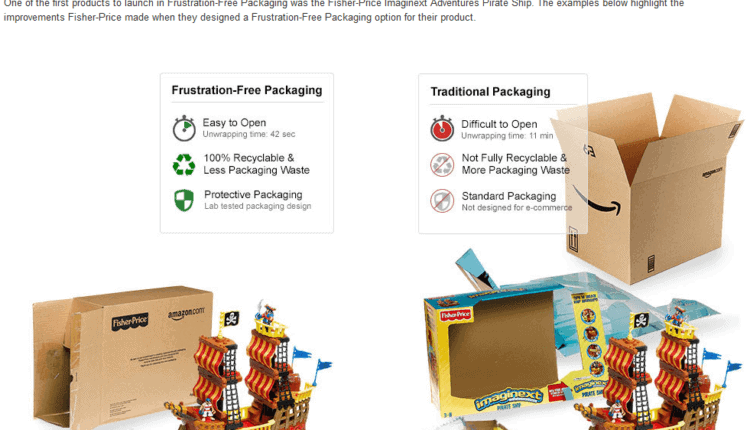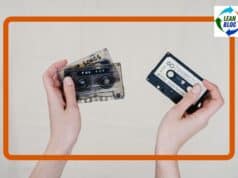By Jason Turgeon:
Amazon made some news at the end of last week when it announced that it will be redesigning its packaging and shipping practices for a variety of products. The initiative is called “frustration-free packaging” and it should be instantly clear what it involves to anyone who has ever bought a child's toy or an electronic doodad. The idea is to eliminate the annoying and wasteful hard plastic clamshells and wire ties that trap so many of our products.
If the connection to Lean isn't immediately clear, let's look at all the types of waste that overpackaging and difficult-to-open packaging add to a product. This video clip from Rocketboom's 2007 Earth Day piece offers up a humorous take on the issue. If you don't have time to watch the video, it shows the waste that accompanies a simple cartridge of printer ink, an item which is roughly the same size as the new iPod nano. True, this item isn't from Amazon, but the only difference is that Amazon would have included a sturdier, heavier box to ship the product in as opposed to the plastic bag.
By the time this item has reached the end user, it comes wrapped in a plastic shopping bag stuffed with ads for other products, a very difficult to open plastic clamshell housing a cardboard box, somewhat unnecessary instructions (these could be permanently attached to the inside of the printer or found online), and various pieces of plastic designed to keep the product from leaking. The pile of waste accompanying the product is many times larger in terms of both volume and weight than the actual product itself. Along with this physical waste is the wasted time of the employees who have to add all that extra packaging, the wasted time of the customer who has to unwrap it all and dispose of it, the wasted fuel it costs to ship all of that excess around the globe, the wasted time and fuel it takes to bring all of that largely nonrecyclable waste to the landfill, and the actual waste of space in the landfill. To top it all off, many customers vehemently despise some of this packaging because it is so difficult to open.
Manufacturers say that they need all this extra packaging to prevent shoplifting, although of course using large packages for small items gives them more shelf space and more room for branding, which might be the real driver. But when you're buying from Amazon, there is no risk to the retailer of shoplifting and no use for marketing material or branding on the packaging. To make matters worse, Amazon then takes the overpackaged items, puts them into an even more oversized box, and fills the extra space in the box with protective plastic.
None of this packaging or shipping material adds the slightest bit of value to the end user. In fact, consumers have been begging for an end to this practice for years now. Amazon, it seems, has finally started to come around and is working with four manufacturers (Fisher-Price, Mattel, Microsoft and electronics manufacturer Transcend) to rid 19 top-selling products of excess packaging.
The Lean implications of this are obvious, as illustrated in the following quote from the company's press release:
One of the first products to launch with Frustration-Free Packaging is the Fisher-Price Imaginext Adventures Pirate Ship, which is now delivered in an easy-to-open, recyclable cardboard box. The new packaging eliminates 36 inches of plastic-coated wire ties, 1,576.5 square inches of printed corrugated package inserts and 36.1 square inches of printed folding carton materials. Also eliminated are 175.25 square inches of PVC blisters, 3.5 square inches of ABS molded styrene and two molded plastic fasteners.
Of course, there are commensurate green benefits, too:
Small items, such as memory cards, are also good candidates for Frustration-Free Packaging. Typically encased in oversized plastic clamshells to deter shoplifting, memory cards are then placed inside larger cardboard boxes for shipment to customers. Working with Transcend, Amazon has eliminated the
hard-to-open clamshell and the need for an additional box. Instead, the cards will now ship inside recyclable cardboard envelopes which use less material. Amazon is working to shrink the envelope size even further.
By eliminating the plastic and shrinking the overall package size dramatically, Amazon is keeping a lot of nonrecyclable PVC plastic out of landfills and using a lot less fuel to ship the smaller and lighter items. Presumably, the reduced packaging will also result in a cost savings for both Amazon and the various manufacturers, too. It's a good move all around. Here's hoping it catches on with other retailers!
See also: No Impact Man's call to eliminate packaging waste
Mark's note: Thanks, also, to Andy for sending this link from amazon with some videos and photos that illustrate the waste that Jason was writing about.
Please scroll down (or click) to post a comment. Connect with me on LinkedIn.
Let’s build a culture of continuous improvement and psychological safety—together. If you're a leader aiming for lasting change (not just more projects), I help organizations:
- Engage people at all levels in sustainable improvement
- Shift from fear of mistakes to learning from them
- Apply Lean thinking in practical, people-centered ways
Interested in coaching or a keynote talk? Let’s talk.
Join me for a Lean Healthcare Accelerator Trip to Japan! Learn More











The link to amazon with more videos and photos appears to be broken.
The link is fixed now, sorry for the defect.
Nice to see them getting on board. If you remember back to the “milk jug debacle” from a few months ago, we have been hearing about this push in package redesign and reduction for some time.
Here’s a link to an interesting article about how Wal-Mart started to work with their suppliers (as opposed to working on them, I guess) to reduce package size. They also mention the package-as-billboard mindset, and how WM guaranteed shelf space for the product in exchange for the reduction.
It really does boggle my mind when companies get so large that there packaging costs run rampant. I see the green packaging initiative as a way for companies to cut costs on frivolous packaging expenses.
I mean, how much money would these companies save on materials, shipping, handling and productivity if they just ordered a box that fit the product. It’s not like they don’t come in every size imaginable, because I know they do.
Maybe there’s just a packaging salesmen out there whose just too good at his job.
Comments are closed.